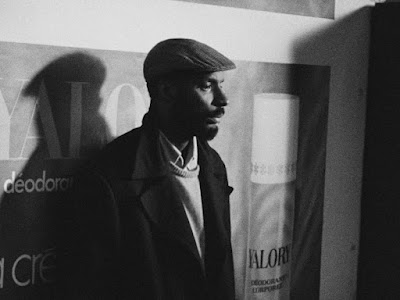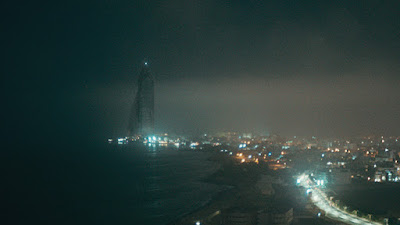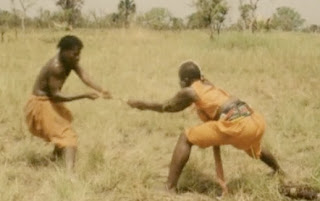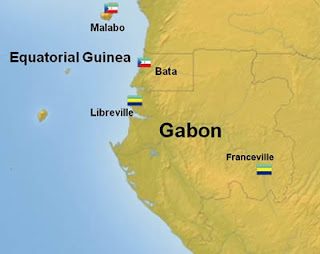Back in February, inspired by an
article in Sight and Sound, I sought out films from Africa. But the search proved challenging as most of the films mentioned in that article were elusive. In the end, of the four titles I got, only
Touki Bouki (1973, Senegal) was highlighted in the article. My other three picks were random, basically whatever I could find. Out of the three, only
When the Stars meet the Sea, a mythical fable from Madagascar was a personal favourite;
Quartier Mozart (1992, Cameroon) &
La Vie Est Belle (1987, Zaire) were decent enough as they provided some interesting moments of humour centered about themes of witchcraft & love. But these four were not enough for a decent spotlight, so I always wanted to find more titles from Africa.
About 10 months on, the search still proved difficult but I managed to track down a few more titles from that Sight and Sound article, plus I got enough different films to atleast have a decent overview. The films also neatly fall into two distinct regional areas -- West Africa & North Africa.
The West – Soccer & Films:
 Pic from: My Travel Guide
Pic from: My Travel Guide
Western Africa has provided a rich dose of films and soccer players over the last few decades. In fact, some of my favourite African soccer players have hailed from West Africa. Players such as Kolo Toure (Ivory Coast), Abedi Pele (Ghana), Emmanuel Adebayor (Togo), George Weah (Liberia), Kanu & Jay Jay Okacha (both from Nigeria) have fascinated me over the last 15 years or so. But these are just a handful of players from an impressive selection. Ofcourse, it is a bit easy to know about West Africa's pool of players because a huge number of them ply their trade in top European teams.
There is also a rich selection of directors and films that have graced the international scene from the complex diversity of 16 countries that constitute West Africa. The films range from artistic & poetic tales to crude commercial works that cater to local cinematic palates. Stories that feature both harsh reality and magical myths are shown in equal measures, sometimes in the same film.
Exile and the return: Sissako & Mambéty
Professional African soccer players may be the highest paid people of the group that leave Africa for European employment. But plenty of other people who leave the continent struggle to earn an income in Europe. Some of them manage to do fine but find themselves longing for life back home. Such is the case of the main character Dramane in Abderrahmane Sissako's
Life on Earth. Dramane (played by Sissako himself) decides that he wants to usher in the new century (2000) in his native Mali.
At the film's start, we find Dramane wandering through a grocery story packed with numerous varieties of cheeses and other food items.


He returns home to a village where the craziness of Year 2000 couldn't be further. It is a peaceful place where one would be thankful for finding even one brand of cheese.

The relaxing life allows Dramane to ponder his life and even the fate of Africans on a global scale.

I first saw Sissako's
Waiting for Happiness (2002) and was impressed. That film was about a young man waiting to head to Europe for a better life (as the title indicates). So his days are spending waiting while watching people go by. Well
Life on Earth is about a character's return back to Africa from Europe to find happiness. But this movie was made first, so it forms an interesting circle with his later work. And, there are some characters in the film who simply sit around and watch the world go by, much like in
Waiting for Happiness.

Exile is also a central idea in Djibril Diop Mambéty's 1992 film
Hyenas. This time however, it is a woman who returns back to her village to seek revenge not peace. When she was a young girl, she was forced into prostitution by a man and had to leave the village in shame. After she has earned riches abroad, she returns to set things right. Besides the revenge aspect, the film is an interesting look at greed and how money can shift politics in one easy go. One absurd segment in the movie revolves around a trial which is rendered useless when the returned woman offers to buy the judge. While all the political games are going on, the hyenas (literally) are simply laughing on the sides. I saw Mambéty's
Touki Bouki (1973) back in February. The title of that surreal road movie translated into ‘Journey of the Hyena’. Well, almost two decades later, Mambéty truly exposes the hyenas disguised as men.
An element of exile is also tackled in
Moolaade. A rich village elder's son is back from France to marry a local woman. The son is prized because of his French education and he returns with modern ideas which are at odds with those of his father. For example, the son supports equal rights for women as opposed to his father who wants the women to be oppressed like the old days. Interestingly enough, both the son in
Moolaade and Dramane in
Life on Earth find inspiration in the words of French poet Aimé Césaire, a person who fought for the rights of French colonies in Africa and the Caribbean.
Old tradition and values vs winds of change:


Certain traditions such as the importance of family are best kept and nurtured. But old traditions such as the oppression of women are best buried and forgotten. Ousmane Sembene's brilliant film
Moolaade looks at a village’s old practice of female circumcision. Problems arise when a local woman supports the decision of a handful of girls to avoid the ritual. Her defiance leads to a mini revolution which shakes the old male dominated rule.
In order to oppress the village people, the elders decide that radios should be banned because they are influencing the minds of the people and exposing the villagers to dangerous foreign ideas. So an order is issued to collect all the village radios and burn them. This scene echoes the burning of books depicted in Fahrenheit 411.


The clash of traditional vs modern values is also depicted in
Haramuya, a film set in the capital of Burkina Faso, Ouagadougo. The film also shows the economic difficulties that exist in the city where some people struggle to earn an income and have to resort to petty theft to make ends meet.
Gaston Kaboré's
Wend Kuuni is mostly the story of an orphaned ‘mute’ child and the family that takes him in. But around the boy, we can see old practices and beliefs dominating the people. Through a flashback, we learn about the traumatic event that caused the boy to lose his voice -- his mother had been accused of being a witch and killed. While the film shows that sometimes old beliefs can cause harm, the movie also highlights how traditional values can benefit as the boy in
Wend Kuuni is lovingly raised by his new adopted family.
Myth and witchcraft:
My first introduction to the witchcraft that existed in Africa was through soccer. June 8, 1990. Argentina, the defending World Cup Champions, stumbled to an unbelievable defeat against Cameroon. No one could have predicated Cameroon's 1-0 win. I still remember that day and the reaction of shock that surrounded that win. Very soon afterwards, almost all neutrals were cheering for Cameroon and its 38 year old star Roger Milla. Most soccer players stop playing soccer in their early 30's, so it was extraordinary to see Milla playing at the top level at 38 (even more remarkably, Milla played in the 1994 World Cup and currently holds the record for the oldest player to have scored goal at the age of 42!). Milla was not supposed to have been in the team for the World Cup because he had retired from the game prior to 1990 but he was asked to play thanks to Cameroon's president. And what a great decision it was as Milla scored crucial goals to lead Cameroon into the quarter-finals. In fact, Cameroon were 7 minutes away from the World Cup semi-finals before England knocked them out. But despite the heroic on-field efforts by Cameroon, talk of witchcraft hovered around the team. It was rumoured that a witch doctor was brought in to bless the team. Was this blessing merely a stunt or an actual belief? Whatever the case maybe, with each subsequent World Cup, the talk of witchcraft does return whenever Cameroon or even Nigeria play. Witch doctors do make headlines predicting World Cup winners and even game scores! Such talks of witchcraft are not limited to Western Africa only but also find roots in almost all parts of Africa with maybe the exception being North Africa.
When did the first mention of witchcraft originate? Probably with some of the oldest myths that can be found in a country’s history. Souleymane Cissé's film
Yeelen beautifully films an ancient Mali myth about a battle between father and son (Nianankoro). Set in the 13th century Mali Empire, Nianankoro must tackle an entire cult group along with his wizard father while trying to restore his family name. The folk story is peppered with elements of magic and witchcraft in depicting the family battle. Because Nianankoro holds the power of magic, he is equally feared and respected.
Kenyan author Ngugi Wa'Thiong'O's book
Wizard of the Crow also features witchcraft in the story about a corrupt African ruler set in a fictional African country. In fact, the book's title comes from a magical curse that a character (a beggar) invokes in order to ward off the policemen chasing him. The beggar is amused to find that a simple hand written sign threatening a curse could have such a powerful effect on the adults and scare them into submission. Such is the power of magic on the minds of the people. I am still in the middle of reading the book so I am not sure if in the end reality will win over black magic.
The Third Wood: witchcraft, love and family
What is the third biggest film industry in the world? This
Guardian article first drew my attention to the answer which stumped me -- Nollywood. The entirely video film industry in Nigeria churns out movies at a rapid rate behind the studios of Hollywood and Bollywood. Since none of the movies are shot on film or shown in a theater, producers and film-makers can quickly shoot and produce movies on video. The films are often distributed and sold at road-side stalls for an eager audience.
Recently
Film Int studied Nollywood in great detail. The essays ranged from history of the film industry to the themes covered and the social & political impacts of these movies. Unfortunately, none of those in-depth essays are available online but here a few quotes:
"
The first Nigerians to shoot feature fictional films on video were artists from the Yoruba travelling theatre tradition, who turned to video when making films on celluloid became prohibitively expensive as the result of Nigeria's catastrophic structural adjustment programme".
Jonathan Haynes, Nnebue: the anatomy of power.
"
The Video film is arguably the most popular mode of cultural expression in Nigeria, produced at a rate which arguably makes Nigeria the hothouse of the genre in the world".
Chukwuma Okoye, Looking at Ourselves in our Mirror.
On Nollywood's essential themes: "
the corruption, moral turbulence and pervasive anxiety of the post-oil-boom era; the garish glamour of Lagos; titillating and dangerous sexuality; melodramatic domestic conflicts; and immanent supernatural forces including both dark cultic practices and Pentecostal Christianity."
Jonathan Haynes, Nnebue: the anatomy of power.
"
From its very beginnings in the 1990s the 'home video' industry in Nigeria has churned out movies that were constructed around a mode of narrative that seeks to naturalize the supernatural by dwelling on stories or plots that blend reality with fantasy. These movies have seized the imagination of audiences in Nigeria, across Africa and the African diaspora. It would seem that Nollywood movies have the strong capacity to appeal to deep currents in the psyche of its captive audiences, particularly its African audiences. The interplay between the magical and the real is part of the African consciousness and is part of the popular culture of postcolonial Africa."
Hope Eghagha, Magical realism and the 'power' of Nollywood home video films.
Even though Nollywood started out in Nigeria, a few articles show how the industry and its practices cover neighbouring Ghana and Ivory Coast as well. One of the most surprizing things I discovered was how a certain number of Nollywood films were inspired by Bollywood films. In fact, some Nollywood films entirely lifted the stories or even dance steps from Bollywood films such as
Taal,
Dilwale Dulhania Le Jayenge and
Maine Pyaar Kiya. In a way, it should not be a surprize that Bollywood's appeal reaches to the Nigerian audiences as the tales of domestic problems and love stories should have no problems finding homes in countries with a strong focus on family life.
Images of a region:



German filmmaker Ralf Schmerberg's 45 minute black and white documentary
Hommage à noir manages to capture both the African village and city life in a series of gorgeous black and white visuals accompanied with resonating music. His camera captures tribal practices, leisurely soaks in all the sights and sounds of a local market and even records a local soccer game. Filmed mostly in Cameroon, the abstract images could be used to apply to certain Eastern, Central and Southern parts of the continent as well.
Moving on to the North...
The North – Football & Cinema:
 Pic from: My Travel Guide
Pic from: My Travel Guide
North Africa also has an amazing selection of top class soccer players but only a few of them leave for Europe. The Egyptian soccer league is the most established of the North African countries with the Moroccan league providing some worthy teams as well. One of my favourite North African players is Mustapha Hadji (Morocco) who was named African Footballer of the year in 1998. He had limited success in the English league but scored some amazing goals for Morocco.
But sometimes football can indeed tale the state of a country or even a region. Professional Egyptian soccer is certainly better known than its other Arab North African counterparts, much like how Egyptian cinema and literature dominates its Northern African neighbours. In fact, for the longest time it was Egyptian film that dominated the entire Arab world. But in recent years, other nations such as Tunisia and even a few of the Middle Eastern countries have started making in-roads towards establishing a unique cinematic identity of their own. Tunisian film-maker Férid Boughedir’s insightful documentary
Caméra arabe (1987) looks at the development of Arab cinema and its rise against a background of turbulent political pressures. It was interesting to watch Boughedir’s documentary but unfortunately, I was only familiar with one director in that 60 minute film -- Youssef Chahine.
Coming of age via the lens of Férid Boughedir:
I first came across Boughedir thanks to his 1996 film
A Summer in La Goulette. Sometimes a movie impacts a person tremendously. In that regards,
..La Goulette was one of the first few foreign films to overwhelm me and leave me breathless. I was seduced by the film and its three female characters, one Christian, one Arab and one Jew. I too wanted to travel to the beaches of La Goulette to bask in the white walled town where the three girls wandered, leaving men speechless in their wake. It was a tremendously enjoyable film and showed that no matter what religion the girls followed, their fathers were equally stressed and worried about their daughters; the fathers wanted to protect their daughters from the eyes of the local boys at all costs but they didn’t realize that it was their daughters who were the ones eyeing boys with equal passion and lust in the first place.
But before Boughedir showed the coming of age of teenage girls, he beautifully portrayed the maturing of a young boy
Halfaouine: Child of the Terraces (1990). The film starts with the following images of the boy.


What are the interesting images that are holding the boy’s attention? Well his mother has been talking him to the local Hamam since he was a little boy but she has not realized her boy is growing up fast and developing an interest in girls and women. His eyes are wide open because he is staring at the naked girls and women around him.
The film is shown from the point of view of the little boy. We see what he sees and at times, we are given a few glimpses into the political revolution that is taking place around him. Not too much time is spent detailing the political struggles against a dictatorship regime because the boy does not understand what is going on. He has no idea why some people get arrested, why some disappear or how writing some harmless slogans on the wall could get someone in trouble. His goal in life is to understand the female species and to that end, he does accomplish his goal.
 The purpose of a film and struggles along the way:
The purpose of a film and struggles along the way:

The last viewed film turned out to be an appropriate choice to close out the African spotlight. Youssef Chahine’s
Alexandria Again and Forever details a film director’s struggle to get a movie made, the struggles he has with himself and his lead actor, the pressure of his producer, the overwhelming expectations of film festivals and the challenges posed by a writer’s strike. Chahine plays the main role in a film that can be described as his
8 ½.

The issues described in the film could possibly plague every film-maker as they could find themselves questioning the relevance of each scene and even the impact that their work would have. And surely there are plenty of directors out there who have one eye on the film festival circuit during their film’s post-production. Indeed, some directors attempt to get their movies completed in time for that prestigious film festival screening. So when a director is working with an end goal already in mind, it is not far fetched to believe that the pressure of expectations could creep up into some of their decision making during the filming.
Final notes:
Africa will once again take centre stage for me at the start of 2008 thanks to the African Cup of Nations soccer tournament held in Ghana from Jan 20 – Feb 10. 16 nations from all corners of Africa would complete in this usually entertaining competition.
Group A: Ghana, Namibia, Guinea, Morocco
Group B: Nigeria, Benin, Mali, Ivory Coast
Group C: Egypt, Sudan, Zambia, Cameroon
Group D: Tunisia, Angola, South Africa, Senegal
Ideally I would have liked to have a film festival to coincide with the soccer games but unfortunately, I would struggle to find films from all nations. As it stands, I have atleast seen films from 8 of the 16 countries. This spotlight was definitely an improvement in terms of getting films from African. But there are plenty of classics out there which are either lost or not distributed in North America. Slowly, but surely, maybe some of these works will start finding their way across the ocean.
Film (Year, Director): Ratings out of 10
Life on Earth (1998, Abderrahmane Sissako): 9
Hyenas (1992, Djibril Diop Mambéty): 8
Moolaade (2004, Ousmane Sembene): 9.5
Haramuya (1995, Drissa Toure): 6.5
Wend Kuuni (1982, Gaston Kaboré): 6
Yeelen (1987, Souleymane Cissé): 8.5
Hommage à noir (1996, Ralf Schmerberg): 8
Caméra arabe (1987, Férid Boughedir): 7
Halfaouine: Child of the Terraces (1990, Férid Boughedir): 8
Alexandria Again and Forever (1990, Youssef Chahine): 7.5
































